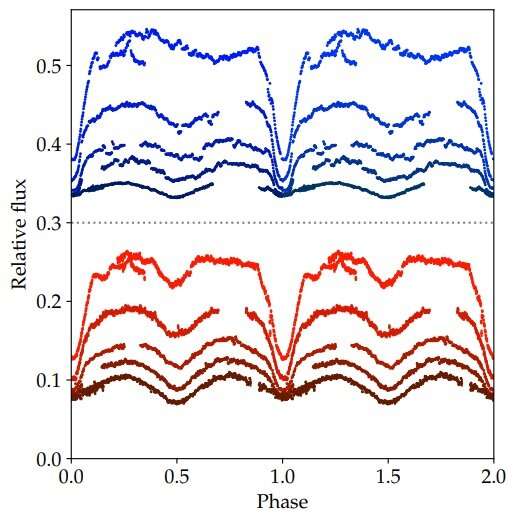The Warwick 1-meter telescope photometry for V1460 Her. Credit: Ashley et al., 2020.
An international team of astronomers has conducted spectroscopic and photometric observations of a cataclysmic variable (CV) known as V1460 Her. Results of the study indicate that the system consists of a fast-spinning white dwarf that accretes matter from its evolved companion star. The finding is reported in a paper published August 30 on arXiv.org.
Cataclysmic variables are binary star systems consisting of a white dwarf and a normal star companion. They irregularly increase in brightness by a large factor, then drop back down to a quiescent state. These binaries have been found in environments such as the center of the Milky Way galaxy, the solar neighborhood, and within open and globular clusters.
V1460 Her is an eclipsing CV with an orbital period of 4.99 hours, containing an over-luminous K5-type donor star. Previous observations of this system have shown that the secondary star dominates the flux in the visible and near-infrared part of the spectrum, and that it experienced two outbursts in the last 14 years.
In order to shed more light on the parameters of V1460 Her and the nature of the donor star in the system, a group of astronomers led by Richard Ashley of University of Warwick, U.K., decided to perform extensive optical and ultraviolet spectroscopic, as well as photometric observations of this CV, after its latest outburst in 2016. The observational campaign made use of the Warwick 1-meter telescope and the William Herschel Telescope (WHT), both located on the island of La Palma in the Canary Islands. The study was complemented by data from the Hubble Space Telescope (HST), and surveys like SuperWASP or ASAS-SN.
"Following the Astronomer's Telegram 9141 (Thorstensen 2016) on 2016 June 11, we decided to take follow-up observations using the Warwick 1-meter telescope on the island of La Palma. We maintained observations for several nights as the target evolved from outburst to quiescence. In addition, we submitted proposals and were granted time for spectroscopic follow-up with the William Herschel Telescope (WHT) on La Palma and the HST," the astronomers wrote in the paper.
The study found that the white dwarf and the donor star have masses of about 0.87 and 0.29 solar masses, respectively. The radius of the donor was measured to be approximately 0.43 solar radii. The results indicate that the donor is oversized by about 50 percent as expected for a K5-type star of this mass.
The astronomers assume that the derived parameters of the donor star in V1460 Her suggest that it is probably the remnant of a phase of high-rate mass transfer. They added that the past, mass loss has happened on a timescale shorter than the donor's Kelvin-Helmholtz (thermal) timescale of around 70 million years.
Furthermore, the observations revealed that V1460 Her exhibits strong pulsations on a period of 39 seconds. The researchers interpret it as the spin period of white dwarf. This makes it one of the fastest-spinning white dwarfs in known CVs.
More information: Ashley et al., V1460 Her: A fast spinning white dwarf accreting from an evolved donor star, arXiv:2008.13242 [astro-ph.SR] arxiv.org/abs/2008.13242
© 2020 Science X Network
























